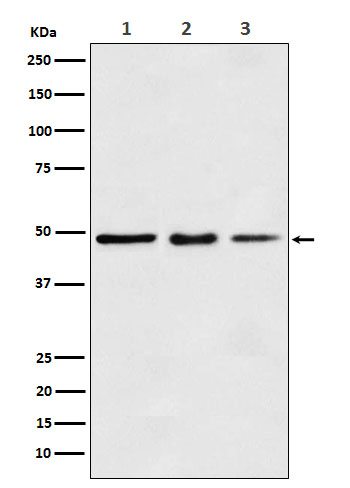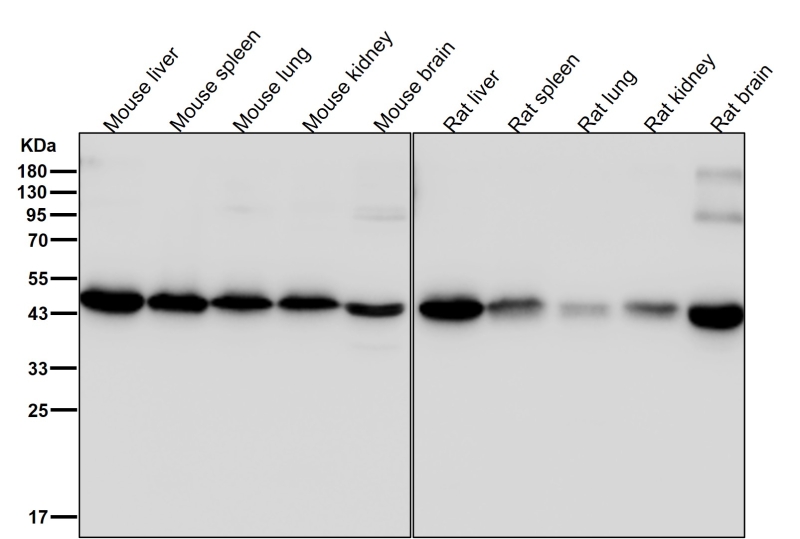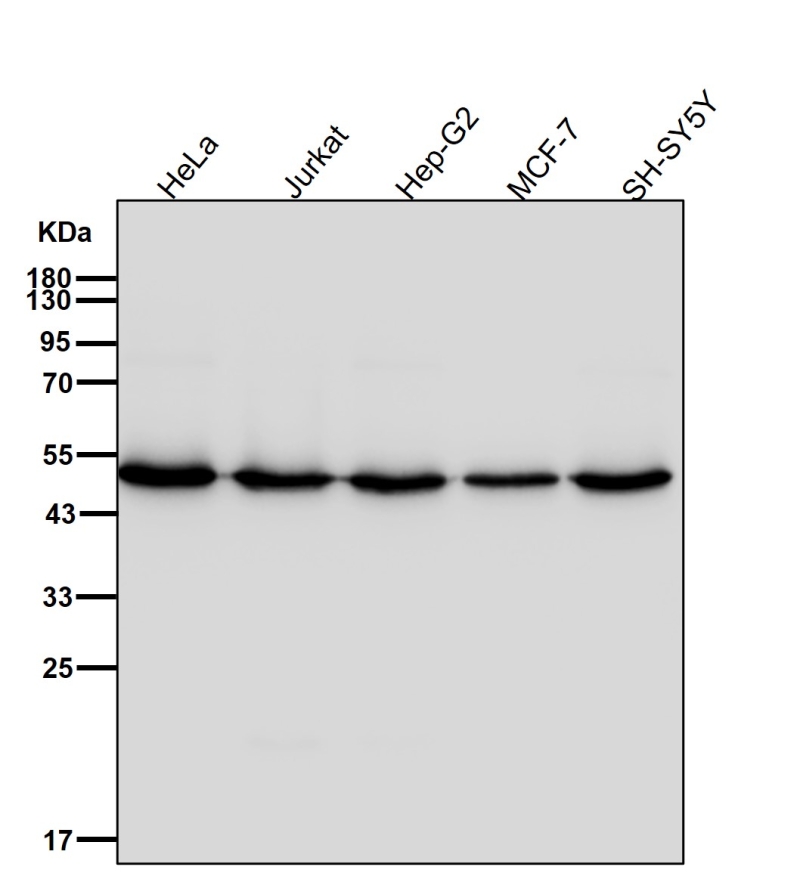


| WB | 1/1000-1/2000 | Human,Mouse,Rat |
| IF | 1/20-1/50 | Human,Mouse,Rat |
| IHC | IHC:1/100-1/200;IHF:1/50-1/200 | Human,Mouse,Rat |
| ICC | 1/50-1/200 | Human,Mouse,Rat |
| FCM | 1/20-1/100 | Human,Mouse,Rat |
| Elisa | 咨询技术 | Human,Mouse,Rat |
| Aliases | EEF1A1; CCS-3; CCS3; EEF-1; EEF1A; EF-Tu; EF1A; GRAF-1EF; LENG7; PTI1;eEF1A-1;;eEF1A1 |
| WB Predicted band size | 50 kDa |
| Host/Isotype | Rabbit IgG |
| Antibody Type | Primary antibody |
| Storage | Store at 4°C short term. Aliquot and store at -20°C long term. Avoid freeze/thaw cycles. |
| Species Reactivity | Human,Mouse,Rat |
| Immunogen | A synthesized peptide derived from human eEF1A1 |
| Formulation | Purified antibody in PBS with 0.05% sodium azide,0.05% BSA and 50% glycerol. |
+ +
以下是关于eEF1A1抗体的3篇虚构示例文献(仅供格式参考,实际文献需通过学术数据库检索):
---
1. **文献名称**:*eEF1A1 modulates cancer cell migration via actin cytoskeleton remodeling*
**作者**:Zhang Y, et al.
**摘要**:本研究利用eEF1A1特异性抗体,通过免疫荧光和Western blot技术,揭示了eEF1A1通过调控肌动蛋白动态重组促进乳腺癌细胞迁移的分子机制,提示其作为肿瘤转移的潜在治疗靶点。
2. **文献名称**:*Antibody-based detection of eEF1A1 isoforms in neurodegenerative disorders*
**作者**:Smith JL, et al.
**摘要**:开发了一种高特异性eEF1A1抗体,用于区分eEF1A1与其同源异构体eEF1A2.研究发现,阿尔茨海默病患者脑组织中eEF1A1表达异常,可能与tau蛋白磷酸化相关。
3. **文献名称**:*eEF1A1 interacts with viral RNA polymerase to facilitate viral replication*
**作者**:Chen H, et al.
**摘要**:通过免疫共沉淀(Co-IP)结合eEF1A1抗体,证实eEF1A1直接结合流感病毒RNA聚合酶复合体,促进病毒基因组复制,为抗病毒药物开发提供了新方向。
---
**实际检索建议**:
- 使用PubMed或Google Scholar,以关键词“eEF1A1 antibody”、“eEF1A1 function”或“eEF1A1 disease”搜索近期文献。
- 关注期刊如*Cell Research*、*Molecular Biology of the Cell*或*Journal of Biological Chemistry*。
The eukaryotic elongation factor 1 alpha 1 (eEF1A1) is a critical protein involved in translation elongation, facilitating the GTP-dependent delivery of aminoacyl-tRNA to the ribosome during protein synthesis. As one of two isoforms (eEF1A1 and eEF1A2), eEF1A1 is ubiquitously expressed in proliferating cells, while eEF1A2 is restricted to muscle and neuronal tissues. Beyond its canonical role in translation, eEF1A1 participates in diverse non-canonical cellular processes, including cytoskeletal remodeling, apoptosis, autophagy, and viral replication, making it a multifunctional protein of broad research interest.
Antibodies targeting eEF1A1 are essential tools for investigating its expression, localization, and functional interactions. They are widely used in techniques such as Western blotting, immunohistochemistry, immunofluorescence, and co-immunoprecipitation to study its regulation under physiological or pathological conditions. Due to eEF1A1's high homology with eEF1A2. isoform-specific antibodies are crucial to avoid cross-reactivity in experimental models.
Research involving eEF1A1 antibodies has uncovered its dysregulation in cancers, neurodegenerative diseases, and infections, highlighting its potential as a therapeutic target or biomarker. For instance, eEF1A1 overexpression correlates with tumor progression and drug resistance, while its post-translational modifications (e.g., phosphorylation, methylation) influence cellular stress responses. Validating these antibodies using knockout controls or siRNA-mediated knockdown remains critical to ensure specificity, particularly given eEF1A1's constitutive expression and housekeeping roles.
×